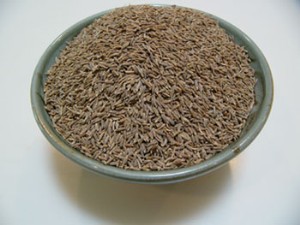Special Feature: Products Sally Recommends
Cumin
 Cumin is a popular spice used in Latin American, Mexican, North African and most Asian cuisines. Cumin seeds grow on a small annual herb of the parsley family called cuminum cyminum. The seeds are yellowish brown in color and are similar to caraway seeds, but a little longer. They have a strong, slightly bitter aromatic flavor. The strong aromatic smell and warm taste of cumin seeds are due to the presence of a volatile oil.
Cumin is a popular spice used in Latin American, Mexican, North African and most Asian cuisines. Cumin seeds grow on a small annual herb of the parsley family called cuminum cyminum. The seeds are yellowish brown in color and are similar to caraway seeds, but a little longer. They have a strong, slightly bitter aromatic flavor. The strong aromatic smell and warm taste of cumin seeds are due to the presence of a volatile oil.
Cumin is believed to be a native of Egypt and Eastern Mediterranean regions, where it has been cultivated since Biblical times. Cumin is mentioned in the works of Hippocrates and Dioscorides. According to Pliny, the ancients took ground cumin seeds medicinally with bread, water or wine. In the thirteenth and fourteenth centuries, it was much in use as a culinary spice in the west. Although it had been a common spice in the times of the Roman Empire, today, cumin usage in Europe is restricted to flavoring cheese in the Netherlands and in France. In Italian cuisine, cumin has little use. However, it is referred to as Roman caraway in many European languages.
Cumin is commercially sold as both seeds and powder. As any other spice, whole cumin seeds retain more aroma than powdered cumin. The main cumin producing countries today are India, Iran, Indonesia, China and the South Mediterranean. Cumin is one of the most typical spices of India. The seeds are used whole, and are fried or dry-roasted before usage. The aroma of the cumin seeds, like most spices, emerges best when dry roasted or added to hot oil. In India, cumin is an important ingredient in several spice mixtures. Similar spice mixtures are also much in use among the descendants of South Indian immigrants in Malaysia or Singapore. In South Eastern and Eastern Asia, cumin is less valued but used occasionally.
Cumin is also very popular in Western to Central Asia; spice mixtures from this region featuring cumin are Yemeni zhoug, Saudi-Arabian baharat and North African tagines. In Central and South American cooking, cumin is also an important spice. It is used in stews and breads in Spain. The popularity of Mexican dishes such as chili con carne, especially in southwestern United States, has made cumin an important spice in the United States.
![]()
Aviyal
Aviyal is practically a cooked salad with coconut, cumin and yogurt dressing. Traditionally, vegetables such as ash gourd, green plantains, string beans, telinga potatoes (suran or zimikand), and drumsticks (moringa oleifea, not chicken!) are used in the preparation of aviyal. Most of the Indian vegetables are available in the U.S. either at Indian stores and/or Latin American grocery stores, Chinese markets and sometimes even at American supermarkets. The following recipe uses seven vegetables. Although not traditional, zucchini, carrots, butternut squash, green beans and potatoes could be used in this curry. The idea is to use as many vegetables as possible. This is one dish that definitely needs curry leaves. Curry leaves, fresh coconut and coconut oil gives aviyal its authentic flavor.
1 medium potato
2 medium carrots
8 pieces moringa oleifea drum sticks (if available)
1 cup of telinga potato pieces (if available)
¼ pound of green beans or string beans
1 green plantain
1 zucchini
1 cup ash gourd pieces
½ teaspoon turmeric powder
salt to taste
1 ½ cups of plain, non-flavored yogurt
3 cups grated fresh coconut
4 to 5 hot green chilies (reduce for milder taste)
1 teaspoon cumin seeds
For seasoning and garnish:
1/3 cup coconut oil
a few springs of fresh curry leaves
Peel and cut plantains, carrots, zucchini, potato, ash gourd, drum stick and telinga potato into 2 ½ to 3 inch length pieces (approximately the size of French fries). Cut green beans or string beans also to three inch pieces. Place the vegetables in a colander and wash them under running water and drain. Using very little water cook the potatoes, carrots, drum sticks, telinga potato and beans along with salt and turmeric in a heavy bottomed pan. These vegetables take slightly longer time to cook than the squash. When they are partly cooked, add the remaining vegetable pieces and combine well. Cook for a few more minutes until the vegetables are just cooked. Stir the yogurt with a tablespoon and add to the vegetables. Simmer for three to five minutes. Grind the coconut, green chilies and cumin seeds to a coarse thick puree, again using just enough water. Remove the puree from the blender and combine with the cooked vegetables. Simmer gently for two to three minutes over low heat to prevent the yogurt from curdling. Remove from the stove and pour coconut oil on top. Garnish with fresh curry leaves.
Makes 6 to 8 servings
![]()
A financial analyst turned freelance food writer, Ammini Ramachandran, writes about the history, culture and cuisine of her home state Kerala, India, on her web site http://www.peppertrail.com. Her recipes and articles have been featured in The Providence journal, Flavor & Fortune, www.leitesculinaria.com, and www.ThingsAsian.com. She is working on a cookbook about the vegetarian cuisine of Kerala against a backdrop of cultural and culinary history. She is a member of the International Association of Culinary Professionals and Culinary Historians of New York.
Note: This information was accurate when it was published. Please be sure to confirm all rates and details directly with the businesses in question before making your plans.



